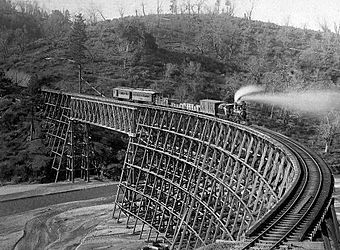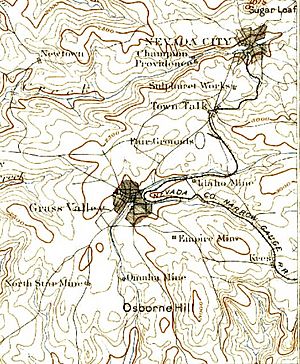Nevada County Narrow Gauge Railroad facts for kids

Mixed passenger and freight train on the Bear River bridge in 1895
|
|
| Overview | |
|---|---|
| Headquarters | Grass Valley, California |
| Locale | Northern California |
| Dates of operation | 1876–1942 |
| Successor | Abandoned |
| Technical | |
| Track gauge | 3 ft (914 mm) |
The Nevada County Narrow Gauge Railroad (NCNGRR) (nickname: Never Come, Never Go) was located in Northern California's Nevada County and Placer County, where it connected with the Central Pacific Railroad. The Nevada County Narrow Gauge Railroad Company incorporated on April 4, 1874, and was headquartered in Grass Valley, California. After two years of construction, passenger and commercial rail services began in 1876 and continued until 1943. The 22.53 mi (36.26 km) line ran from Colfax, north through Grass Valley to Nevada City. At one time, the railroad was notable for having the highest railroad bridge in California, the Bear River Bridge, built in 1908.
History
The need for rail service in the semi-mountainous and wooded area of Grass Valley and Nevada City was precipitated by mining operations subsequent to the California Gold Rush. In addition, timber operators wanted to make their land accessible to the Southern Pacific Company in Colfax. On March 20, 1874, the California legislature and Governor Newton Booth approved the right to build and operate a 3 ft (914 mm) narrow gauge from Colfax, through Grass Valley, to Nevada City. On June 20, an Act of Congress granted the railroad right of way through public lands.
J. H. Bates estimated that construction and equipment would total $411,132. Only one bid came in and it was for $500,000, signed by M. F. Beatty; he received a lump sum of $500,000. Construction began January 1875. Turton & Knox were subcontracted for earthwork. John Flint Kidder was the chief engineer. Within two months, 600 men were employed in the railroad's construction.
Construction included two bridges, two tunnels, and five trestles. After leaving the Colfax depot, the road headed north, parallel with the Central Pacific Railroad, then crossed Bear River, and into Nevada County. One of the first stations was at the town of You Bet, which serviced the Goodwin Drift Gravel Mine. The road proceeded into Chicago Park, a fruit and grape growers colony, and then continued into Grass Valley. All cars and locomotives had Westinghouse railway brakes, and cars used for passenger service had Miller Platform couplers. As the first contractor, Beatty, was unable to complete the project, a second, J. K. Bynre, was brought in; construction was completed in the spring of 1876. The inaugural train, from Colfax to Grass Valley, ran on April 11 and by May 20, the first train reached Nevada City.
The company's first President was John C. Coleman, president of the North Star Mine. Kidder, the builder, decided to settle down in Grass Valley, becoming the General Superintendent, and in 1884, became the second president. Upon his death in 1901, Kidder's widow, Sarah, took over, becoming the first female railroad president in the world.
In September 1907, a 3.56 mi (5.73 km) "cut-off", at a cost of $132,285 was built, bettering the grade. The following year, construction was completed on the Bear River Bridge. By 1912, the NCNGRR was running three mixed trains daily, each way, between Nevada City and Colfax, while a fourth mixed train ran daily, each way, between Grass Valley and Colfax. Sarah Kidder sold her interests in 1913 and retired to San Francisco.
In 1926, Earl Taylor and his associates purchased the railroad for $1. With the outbreak of World War II, they sold it in 1942 for $251,000 to Dulian Steel Products Company and the last train to run over the line was on May 29.
Each combination coach had a small iron safe in the baggage compartment. Though $200,000,000 in gold was hauled out of Nevada County by the NCNGRR during its operation, there was never an attempted robbery.
Statistics
- Length:
- Placer County: The main line was 5.62 mi (9.04 km) long, and had 1.73 mi (2.78 km) in spurs and sidings
- Nevada County: The main line was 16.79 mi (27.02 km) long, and had 2.39 mi (3.85 km) in spurs and sidings.
- Maximum grade: 116 ft per mile (22 m pro km), 1:45.7 or 2.2%
- Minimum radius of curvature: 302.9 ft (92.3 m).
- Weight: 35 pounds per yard (17.4 kg/m)
- Degrees of curvature: 7944
- Length of tangents: 53,908 ft (16,431 m)
- Ascents from Colfax: 1,159 ft (353 m)
- Descents from Colfax: 1,042 ft (318 m)
- Initial rates:
- Passenger services: $0.10/mile
- Freight services: $0.20/ton/mile
- Running time:
- Absolute: 1 hour, 40 minutes
- Mixed trains: Two hours
- Average stops: Four
Locomotives
| Number | Name | Type | Builder | SN | Built | Acquired | Disposition | Notes |
|---|---|---|---|---|---|---|---|---|
| 1 | Grass Valley | 4-4-0 | Baldwin Locomotive Works | 3762 | 7/1875 | 1875 | Scrapped 1936. | |
| 1 | Glenbrook | 2-6-0 | Baldwin Locomotive Works | 3712 | 3/1875 | 1936 | Sold to Hope & Will Bliss in 1942. | Purchased from the Southern Pacific (operated on the Lake Tahoe Railway & Transportation Company). Originally built for the Carson & Tahoe Lumber & Fluming Company #2. Never operated on the NCNG In operational condition at the Nevada State Railroad Museum in Carson City, Nevada. |
| 2 | Nevada | 2-6-0 | Baldwin Locomotive Works | 3758 | 7/1875 | 1875 | Scrapped 1933. | |
| 3 | 4-4-0 | Baldwin Locomotive Works | 4172 | 9/1877 | 1877 | Scrapped 1916. | ||
| 4 | Santa Cruz | 0-6-0 | Porter-Bell | 218 | 1875 | 1899 | Scrapped 1916. | Purchased from the Lake Valley #1. Originally Santa Cruz & Felton, then Nevada-California-Oregon #1. |
| 5 | Tahoe | 2-6-0 | Baldwin Locomotive Works | 3709 | 3/1875 | 1899 | Sold in 1940 to Frank Lloyd Movie Productions. | Purchased from the Carson & Tahoe Lumber & Fluming Company #1. Later donated by Universal Studios to the Nevada County Narrow Gauge Museum where it is on display. |
| 6 | 2-6-0 | New York Locomotive Works | 22 | 1883 | 1915 | Scrapped 1921. | Purchased from the La Dicha & Pacific #1. Originally Toledo, Cincinnati & St Louis #49, then Portland & Willamette Valley #3, then South Pacific Coast #25. | |
| 7 | 4-4-0 | Baldwin Locomotive Works | 5782 | 8/1881 | 1929 | Scrapped 1934. | Purchased from Carson & Colorado #4. | |
| 8 | 2-8-0 | Baldwin Locomotive Works | 4938/
6057 |
1880
2/1882 |
1933 | Sold in 1942 to Pacific Portland Cement #8 | Made from Denver & Rio Grande Western locomotives. The boiler of #42 and the Running Gear of #283. Sold in 1943 to Imperial Portland Cement #8. Scrapped in 1947. | |
| 9 | 2-8-0 | Baldwin Locomotive Works | 41300 | 4/1914 | 1933 | Sold in 1942 to Dulien Steel Products. | Purchased from the Southern Pacific (narrow gauge) #1. Originally Nevada-California-Oregon #14. Scrapped in 1946 as U.S. Navy #17. |
Other motive power
Engine 10 was built by Fate-Root-Heath Company of Plymouth, Ohio, and was in service only during the first six months of 1936.
Engine 11 was built by Whitcomb Manufacturing Company of Rochelle, Illinois, and was in service 1936–1942.
Notable passengers
There were several notable passengers, including presidents Ulysses S. Grant and Theodore Roosevelt, singer Emma Nevada, and Britain's Prince Albert.
Historic recognition
In the centennial year after the railroad began operations, E Clampus Vitus erected a historical marker in Colfax at 39°6.011′N 120°57.159′W / 39.100183°N 120.952650°W near the old NCNGRR depot, the southern end of the line. The Nevada County Narrow Gauge Railroad & Transportation Museum was created in recent years near the northern end of the line in Nevada City.











